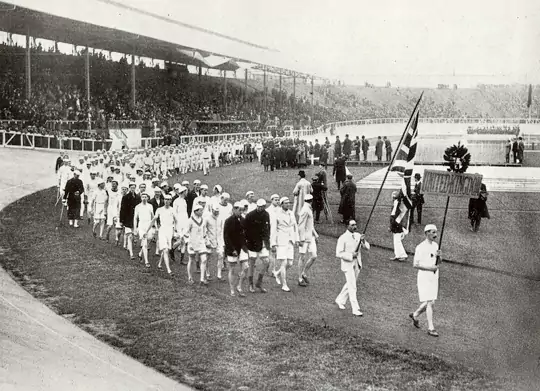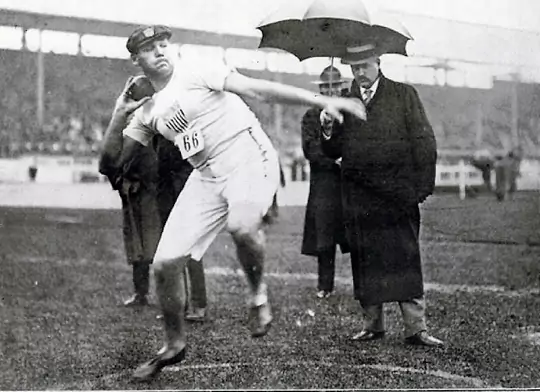This article [The First Olympic Protest] was originally published in The Public Domain Review [http://publicdomainreview.org/2012/07/25/the-first-olympic-protest/] under a Creative Commons Attribution-ShareAlike 3.0. If you wish to reuse it please see: http://publicdomainreview.org/legal/

✅ AI Essay Writer ✅ AI Detector ✅ Plagchecker ✅ Paraphraser
✅ Summarizer ✅ Citation Generator
By Rebecca Jenkins
Just over 100 years ago, London hosted its first Olympic Games: the Fourth Olympiad of 1908. It was a fledgling version of what we have today—only 2023 athletes competed, approximately the same number that will contest the athletic events in 2012.
Of course, the Olympic Games were rather different then—there was no torch relay, or spectacular opening ceremony with a stadium transformed by pageants of England’s green and pleasant land. In 1908, the tug-of-war was a medal winning contest, as were massed gymnastic displays (very popular with the northern European nations with military conscription) and marathon runners were not encouraged to re-hydrate, so the winning time would not have even qualified a modern athlete for the Olympic team today.
It is well known that in 1908, the marathon was run for the first time at the modern Olympic distance of 26 miles, 385 yards. But what is often overlooked is that these Edwardian games were the first to have an opening ceremony revolving around a parade of nations; in short, the first London Olympics witnessed the birth of Team GB.
It has been said that whereas the Germans excavated Ancient Olympia and the French reanimated its spirit, the Edwardian sons of the British Empire set out to organize it. In the first Games of the modern Olympics, any one—or perhaps more accurately, any sporting man (Baron de Coubertin, the “father” of the Olympic movement, did not approve of women performing in public sporting contests)—who had the private means to turn up at the venue could put himself down to compete.
 British Olympic Association in 1909.” width=”540″ height=”391″ class=”size-full wp-image-19587″ /> Photograph of Team GB in the opening ceremony’s ‘parade of nations,’ from the Fourth Olympiad 1908 London Official Report published by the British Olympic Association in 1909.
British Olympic Association in 1909.” width=”540″ height=”391″ class=”size-full wp-image-19587″ /> Photograph of Team GB in the opening ceremony’s ‘parade of nations,’ from the Fourth Olympiad 1908 London Official Report published by the British Olympic Association in 1909. London Illustrated News, July 1908.” width=”540″ height=”375″ class=”size-full wp-image-19588″ /> Engraving of the opening parade from the London Illustrated News, July 1908.
London Illustrated News, July 1908.” width=”540″ height=”375″ class=”size-full wp-image-19588″ /> Engraving of the opening parade from the London Illustrated News, July 1908.Faced with an increasing interest in the Games, the small group of gentlemen who set out to organize the London Olympics of 1908 decided it would be more efficient only to accept contestants registered through national teams selected through national Olympic associations. This administrative decision was reinforced by an opening ceremony in which the athletic teams paraded into the stadium dressed in athletic or national costume, four abreast behind “their respective representatives, [bearing] the flag and entablature of their country.”
The eye of the Olympic spectator was moved irrevocably from the individual athlete to the flag they wore on their chest. And flags, as the Edwardian organizing committee soon discovered, cause conflict.
In 1908, the US Olympic Committee sent their largest team so far to the Olympic Games: 122 men (no women), in team costume with the stars and stripes on their breast. The managers of Team US 1908 were determined that they were going to sweep England off the athletic map. The ground they chose was track and field and their modern gladiators were dominated by Irish American track and field stars from New York.
Even before the Games began, the press were reporting spats between the American managers and the British Olympic Association over the rules governing pole vaulting (the British organizers had sent out their rules in advance, assuming no one would complain. After all, as the Daily Mail wrote: “We have carried our dress clothes and our games throughout the world.”).

1908 postcard (cropped) showing King Edward VII at the opening ceremony.
It was, perhaps unfortunate, therefore, that in the rush to prepare the White City stadium for King’s arrival to open the Games on the afternoon of Monday, July 13th, 1908, the national flags run up the poles included those of Japan and China (neither of whom would send representatives to the Olympics games for some years yet), but omitted those of Sweden and the United States of America.
The Crown Prince of Sweden, president of the Swedish Amateur Athletic Association, had been a key supporter of the Olympics since their revival. He and the Swedish Government had—unlike the British government—provided substantial subsidies to send the third largest national team to London for the 1908 Games. And, Prince Gustavus, an honored guest of the British King and Queen, was among the royal party in the royal box.
The Prince was polite in front of his royal hosts about the omission of his national flag. The American Committee however suspected a deliberate insult. They produced their own stars and stripes and had it run up the pole. The Swedes had to make do with the single flag carried before their team in the parade.
The parade climaxed with the massed ranks of athletes behind their flagbearers facing the royal box. With a fanfare from the trumpeters of the Life Guards, the flag were dipped to salute King Edward VII—every flag, that is, except the Stars and Stripes held by the Californian law student and shot putter, Ralph Rose.
 British Olympic Association in 1909.” width=”540″ height=”392″ class=”size-full wp-image-19590″ /> Photograph of Ralph Rose in shot-putting action, from the Fourth Olympiad 1908 London Official Report published by the British Olympic Association in 1909.
British Olympic Association in 1909.” width=”540″ height=”392″ class=”size-full wp-image-19590″ /> Photograph of Ralph Rose in shot-putting action, from the Fourth Olympiad 1908 London Official Report published by the British Olympic Association in 1909.The British press at the time overlooked the incident, but the Irish paper in New York, The Gaelic American, picked up Rose’s gesture and made much of it. When an American sports journalist revived the story in the 1950s, it told of Ralph Rose being “taken aside” the night before the opening ceremony by a core of Irish American athletes determined to make a stand against the British tyrant who oppressed the Irish. “This flag dips to no earthly king,” the young democrat was supposed to have said as he held his flag high.
Historians dispute whether the words were said by Rose or were a later embellishment to the story, but the fact remains that after 1908, the national Olympic team was here to stay and the 1908 US team had made the first Olympic political protest.
Follow us on Reddit for more insights and updates.





Comments (0)
Welcome to A*Help comments!
We’re all about debate and discussion at A*Help.
We value the diverse opinions of users, so you may find points of view that you don’t agree with. And that’s cool. However, there are certain things we’re not OK with: attempts to manipulate our data in any way, for example, or the posting of discriminative, offensive, hateful, or disparaging material.